New York, New York Blu-ray Movie
HomeNew York, New York Blu-ray Movie 
Metro-Goldwyn-Mayer | 1977 | 163 min | Rated PG | Jun 07, 2011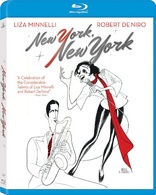
Movie rating
6.5 | / 10 |
Blu-ray rating
| Users | 0.0 | |
| Reviewer | 3.5 | |
| Overall | 3.5 |
Overview
New York, New York (1977)
An egotistical saxophone player and a young singer meet on V-J Day and embark upon a strained and rocky romance, even as their careers begin a long uphill climb.
Starring: Liza Minnelli, Robert De Niro, Mary Kay Place, Barry Primus, Lionel StanderDirector: Martin Scorsese
| Drama | 100% |
| Romance | 35% |
| Period | 28% |
| Music | 13% |
| Musical | 13% |
Specifications
Video
Video codec: MPEG-4 AVC
Video resolution: 1080p
Aspect ratio: 1.66:1
Original aspect ratio: 1.66:1
Audio
English: DTS-HD Master Audio 5.1
French: DTS 5.1
Spanish: Dolby Digital Mono
Italian: DTS 5.1
German: DTS 5.1
Spanish: DTS 5.1
Japanese: Dolby Digital 2.0
Japanese only available on Japanese menu settings
Subtitles
English SDH, French, German SDH, Italian, Japanese, Portuguese, Spanish, Danish, Dutch, Finnish, Greek, Hebrew, Hungarian, Mandarin (Traditional), Norwegian, Swedish, Thai
Discs
50GB Blu-ray Disc
Single disc (1 BD)
Playback
Region free
Review
Rating summary
| Movie | 3.0 | |
| Video | 4.0 | |
| Audio | 3.5 | |
| Extras | 4.0 | |
| Overall | 3.5 |
New York, New York Blu-ray Movie Review
These Vagabond Blus
Reviewed by Michael Reuben June 28, 2011New York, New York, Martin Scorsese's love letter to Hollywood studio films of the Forties and
Fifties, can be either entrancing or infuriating, depending on your mood. I've had both reactions,
sometimes during the same viewing. As Scorsese explains in the "Introduction" created for the
2005 DVD release and included on the Blu-ray, he was trying to meld the contemporary style of
emotionally charged acting he'd employed in Mean Streets with the artificial studio style that had
enchanted him as a boy, with its sound stages and backlots, its painted backgrounds and obvious
rear projection, its stylized make-up and lighting, even its 1.37:1 aspect ratio (which Scorsese
tried and quickly abandoned). Whatever you may think of the resulting mixture, there's been
nothing quite like it either before or since.
New York, New York was released in 1977 to poor box office and bad reviews. The initial
running time was 2 hours, 35 minutes, which was subsequently cut by 19 minutes for a re-release. In 1981, a 2 hour, 43 minute version was
released, restoring the full sequence commonly
referred to as "Happy Endings". This is now considered the definitive version, and it's the
version presented on this Blu-ray.
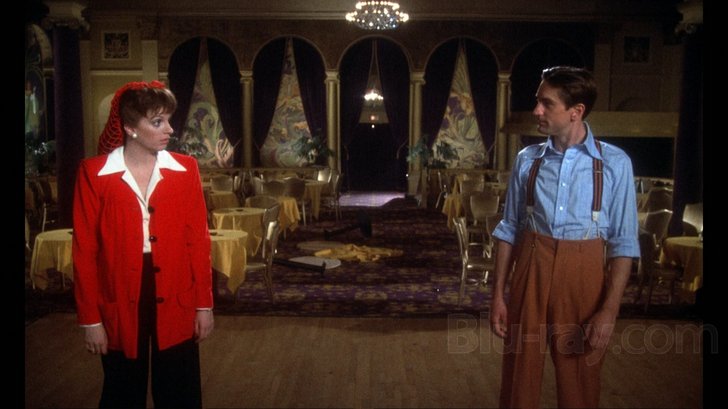
For a nearly three-hour film, NY, NY has a simple story, and a big reason it strikes some viewers as bloated is that the story could be told in half the time or less. But in this film, style (or more accurately, styles, plural) is everything. If you're impatient for the story to move forward, you'll miss the best the film has to offer.
On VJ Day, August 14, 1945, a man in a distinctive blue Hawaiian shirt moves through the crowd celebrating in Times Square. You know immediately that you're in movie-land, because of how the camera keeps following that blue shirt, losing it sometimes, but always finding it again. Its owner is Jimmy Doyle (Robert De Niro), a fast-talking saxophone player, who, shortly, enters a giant USO dance where he tries to pick up every woman in sight.
One such woman is Francine Evans (Liza Minnelli), a USO entertainer who is there because her girlfriend was asked by the soldier she's dating to "bring someone for my friend". Jimmy persists in trying to get Francine's phone number well past the point of being annoying (to both Francine and the audience), but by the end of the evening they've made an acquaintance of sorts. The next morning, luck and the machinations of screenwriters conspire to put them in the same cab to an audition in Brooklyn. Jimmy plays, Francine sings, and the club owner (Dick Miller) hires them both. A partnership is born.
The rest of the film chronicles the rise and fall of Jimmy's and Francine's relationship, musically and romantically. Just as she's on the verge of succumbing to Jimmy's relentless advances, Francine's agent, Tony (Lionel Stander), gets her a good job on the road with the Frankie Harte Orchestra (Frankie is played by a world-weary Georgie Auld). But Jimmy tracks her down, auditions for Harte and joins the band. They begin touring together, sometimes happily, sometimes at each other's throats. Among many sore points for Jimmy is Francine's popularity. It's clear that her disciplined, "big band" style of singing is a draw for audiences. Jimmy's looser (and louder) jazz arrangements are not. Any similarity to A Star Is Born is strictly intentional.
After a year or so, Jimmy and Francine end up back in New York. (I'm deliberately skipping over exactly how this happens.) Jimmy begins performing at a club in Harlem, where jazz is more welcome. (The band's leader, Cecil Powell, is played by "The Big Man", Clarence Clemons, who passed away only days before this review's publication.) Tensions between Jimmy and Francine reach the breaking point over two issues: the impending birth of their child, about which Jimmy has always been ambivalent, and the prestigious record contract with Decca Records that Tony has landed for Francine. It's all too much for Jimmy, and they part ways.
The last section of NY, NY charts Francine's rise to superstardom through the device of her film Happy Endings, which starts as a movie-within-a-movie, then becomes a Broadway play-within-a-movie-within-a-movie. These were the first sequences Scorsese shot, using the same MGM soundstages where Vincente Minnelli shot his classic musicals, and they're the most enjoyable part of NY, NY, because they're pure old Hollywood. After filming them, Scorsese dove head-first into his experiment of fusing old-style moviemaking with new-fangled acting. But here he was simply expressing his love for classic studio pictures, and doing it with a star (Liza Minnelli, in her prime) who could deliver a performance capable of supporting that grand style. As much as one may be aware of the irony that the actress Francine is delivering a "happy ending" that will elude the character Francine, it hardly matters. The production is so gorgeous and so elaborate that no one cares.
Six years after leaving New York, Francine returns in triumph. By this point, Jimmy has established his own nightclub, where he can play what he likes, host other musicians, and rule over his domain as Rick ruled over his bar in Casablanca . He seems to have settled down. He goes to see Francine perform, and when she spots him in the crowd, she performs the song they wrote together, the now indelible Kander & Ebb anthem "New York, New York". After the show, they have a brief, bittersweet reunion, but then they part again.
The incompatible duality between Francine and Jimmy is so clearly laid out that the film might as well come with a diagram. He's spontaneous; she's organized. She's domestic; he prefers hotel rooms. He improvises; she plans. He's quick to anger; she's level-headed (until pushed too far). However, if one does nothing but tick off these differences, there's little point in watching the film. What interests Scorsese is not how this couple is divided but what happens when they collide. If the visual style of NY, NY was derived from directors such as Minnelli, Curtiz and Cukor, the acting style came from Cassavetes. The actors were encouraged to improvise around the script, and while that approach, in talented hands, can achieve great emotional depth, it usually comes at the price of concision. Viewers must have the patience for a slow, deliberate ride, and many simply lose interest. The film's predicament is inadvertently summarized by an offhand exchange between Jimmy and Francine's agent, Tony:
Jimmy: Doesn't that make sense to you?That's Tony's way of telling Jimmy: "I don't care enough to think through what you just said." Likewise, viewers who haven't the patience to follow De Niro and Minnelli as they plumb the depths of Jimmy and Francine will simply switch off, but those who follow along will experience uniquely intense emotions. A word of warning, though: Not all the emotions evoked by NY, NY are pleasant. Cinematographer Laszlo Kovacs notes in the accompanying documentary that one argument scene was so grueling that he found himself turning away from the camera, even as he was filming.
Tony: It should, but it doesn't.
New York, New York Blu-ray Movie, Video Quality 
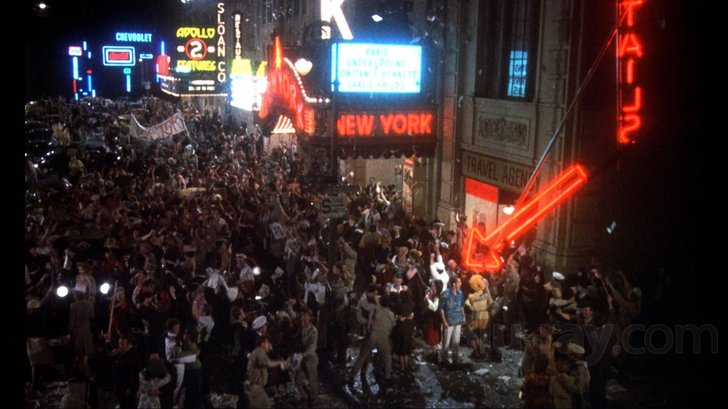
As with all recent MGM Blu-rays, there is no information about the source material. Scorsese
notes in the documentary that he was unable to shoot the film in the Technicolor process he
originally envisioned, because it was no longer available. It's unclear whether this accounts for the
film's grainy texture, or whether a superior image could be harvested from existing sources, if
MGM were able to devote more resources to the project than its current finances allow. The good
news is that the grain in the image hasn't been sandblasted away by digital postprocessing, and,
for the most part, the grain remains sufficiently under control that it doesn't interfere with the
viewer's enjoyment.
More good news: The source material for NY, NY is in much better condition than many other
MGM films from this period that I have reviewed recently. There is hardly anything in the way of
visible dirt, scratches or other print damage. Even if a new image harvest were to be done in the
future, it's unlikely that NY, NY has ever looked better in theatrical prints than it does on this
Blu-ray. Outside the theater, I do know that the film has frequently looked worse, because prior
home video formats lacked sufficient detail to resolve the elaborate imagery with which Scorsese
and his collaborators packed the frame.
Colors in the 1080p, AVC-encoded presentation are rich and varied without oversaturation or
blooming. Black levels are sufficiently good that the many night scenes are full of well-delineated detail. Indeed, the real triumph of this Blu-ray is to
bring home the full extent of the
stylized artificiality of the many elaborate sets and costumes designed by the creative team to
realize Scorsese's vision of an old-style studio film in an era when that system no longer existed.
As one watches Jimmy and Francine in a soundstage forest, or Jimmy missing a train that's an
obvious fake, or the many New York street scenes that are clearly not real city streets, you spot
the artifice just as surely as you know, e.g., while watching White
Christmas that the actors most
assuredly are not in Europe, Florida or Vermont. But you play along anyway. That's how movies
used to work. Viewers were willing to "play along" with the film, instead of leaning back in their
seats and insisting that every last detail be one hundred percent convincing.
Perhaps the most problematic sequence is the long, elaborate shot accompanying Francine's
rendering of "But the World Goes Round", which provides a critical transition to a montage of
her solo career. The shot is grainier than the rest of the film and also appears to be less stable,
with a distinct pulsing in the image. However, this does not appear to be a flaw in the Blu-ray. As
described by Kovacs in his short commentary, the shot involved elaborate rear projection, which
would account for both the pulsing and the change in texture.
New York, New York Blu-ray Movie, Audio Quality 
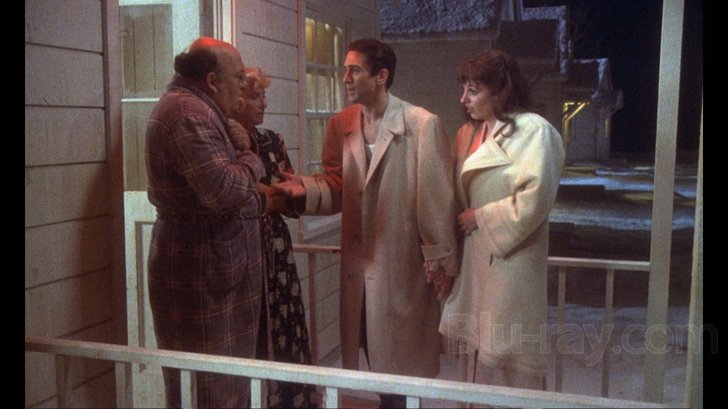
The soundtrack is presented in DTS-HD MA 5.1, but the rear two channels might as well not be there. Consistent with his desire to mimic the look and sound of Forties and Fifties films, Scorsese has kept the sound entirely in the front, as if NY, NY were a mono film with a very wide front presence. There's a sense of spaciousness to the musical numbers, but no sense of stereo separation. The sound of the various jazz groups and orchestras has a pleasant tonality, and Liza Minnelli's vocals have been well recorded and reproduced. Dialogue is always clear and centered.
New York, New York Blu-ray Movie, Special Features and Extras 
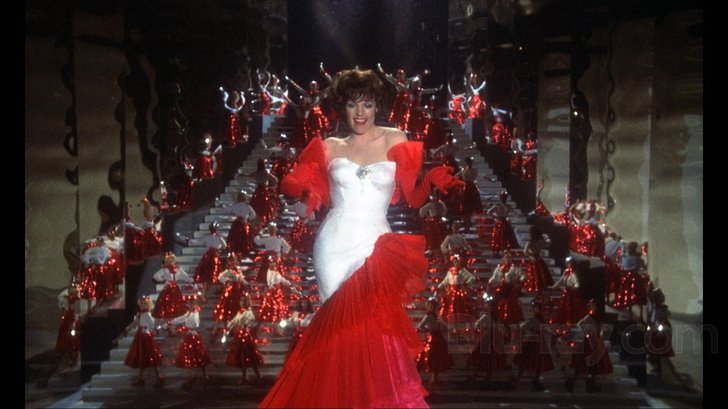
NY, NY has been getting "special editions" since 1993, when MGM issued a four-disc box set on
laserdisc. Some features have been picked up from edition to edition - notably, the commentary
- while others have disappeared with no explanation. The features on the Blu-ray have been
ported over from the two-disc special edition DVD released by MGM in 2007. Those previously
included on the single-disc special edition DVD released in 2005 are marked with an asterisk.
Not included from the earlier DVDs is a photo gallery, which featured posters, lobby cards and
storyboards.
Not even for a Martin Scorsese picture has Fox/MGM been willing to depart from its insidious
habit of mastering titles with no main menu but with BD-Java, omitting the ability to set
bookmarks. No BDJ-encoded disc should ever lack bookmarking. BDJ prevents the user from
stopping playback and starting from the same position, and bookmarking is the only workaround.
Its omission is inexcusable, and I will continue to dock these discs in the features ranking until
Fox/MGM ends this practice.
- *Commentary by Director Martin Scorsese and Film Critic Carrie Rickey: This
commentary first appeared on MGM's "Deluxe Collector's Edition" laserdisc set of NY, NY
released in 1993 and has been repeatedly recycled on subsequent DVDs and now Blu-ray.
Scorsese and Rickey were recorded separately, and their comments edited together, with long
periods of silence in between.
Scorsese's comments are significantly more informative, although he provides frustratingly little technical information and concentrates more on thematic elements. Still, what's there is valuable. Among other insights, Scorsese describes how NY, NY taught him to plan his shots musically, timing this particular shot for so many bars, then the next shot for so many bars. He came to consider this approach to be true directing, as opposed to obtaining coverage from all angles and creating the film later in the editing room. He says he applied the approach to the choreographed fight sequences in Raging Bull, and anyone familiar with that film can appreciate the effect.
Scorsese also notes near the end of his comments that Jean-Luc Godard liked NY, NY and was able to articulate its themes for Scorsese better than Scorsese himself.
Rickey's comments run toward the dry and academic, but she makes worthwhile points. - *Introduction by Martin Scorsese (SD; 1.33:1; 5:36): This brief overview of Scorsese's artistic goals was assembled from the longer documentaries listed below. It was the only featurette included on the 2005 DVD edition.
- *Alternate Takes, Deleted Scenes (SD; 1.66:1, non-enhanced; 19:14): Most of the scenes that play in this continuous series are alternate takes containing improvs. However, the last few scenes show an alternate ending that's interesting but clearly would have been wrong for the film.
- The New York, New York Stories, Part One (SD; 1.33:1; 25:31): Made in 2005, this documentary traces the history of NY, NY, beginning with the formation of the producing partnership between Irwin Winkler and Robert Chartoff. It was they who developed the initial script with writer Earl Rauch. Winkler met Scorsese at a screening of Mean Streets, and when Scorsese heard that Winkler was developing a script set in the "big band" era, he asked to read it. Winkler and Chartoff discuss casting, and Scorsese and Kovacs discuss the look of the film. Editor Tom Rolf notes the irony (some might say the injustice) that Minnelli, who brought Kander & Ebb into the project, did not have a hit with the title song, which wasn't even nominated for an Oscar. It didn't get noticed until two years later, when Frank Sinatra recorded it. Today most people probably don't realize it was written for a movie.
- The New York, New York Stories, Part Two (SD; 1.33:1; 26:58): In the second part of the documentary, Scorsese discusses the style of the movie and the approach taken by the actors, especially De Niro. Kovacs describes the technical challenge of lighting and moving the camera when you have actors improvising. Editor Rolf is far less sanguine on the subject of improvisation ("Editors hate it!"). All three comment on the movie's themes, and producer Winkler describes the encouraging preview in San Francisco, followed by the disappointing opening two weeks later. Winkler also describes how the film inspired Bertrand Tavernier's 'Round Midnight.
- Liza on New York, New York (SD; 1.33:1; 22:09): Interviewed in 2005, Minnelli covers a variety of topics, including her childhood in Hollywood, the experience of making NY, NY, her feelings about the film (all positive), and her favorite song ("But the World Goes Round").
- Commentary on Selected Scenes by Laszlo Kovacs, ASC (10:14): Kovacs discusses the technical demands of: (1) the long crane shot that introduces Jimmy in Times Square on VJ Day (36 takes!); (2) the crane shot immediately following at the USO dance where Jimmy meets Francine; (3) the red neon-lit club where Jimmy and Francine first meet Artie Kirks from Decca records; and (4) "But the World Goes Round".
- *Trailers (SD; 185:1, non-enhanced): Both the teaser trailer (2:07) and the full theatrical trailer (3:27) are included.
New York, New York Blu-ray Movie, Overall Score and Recommendation 
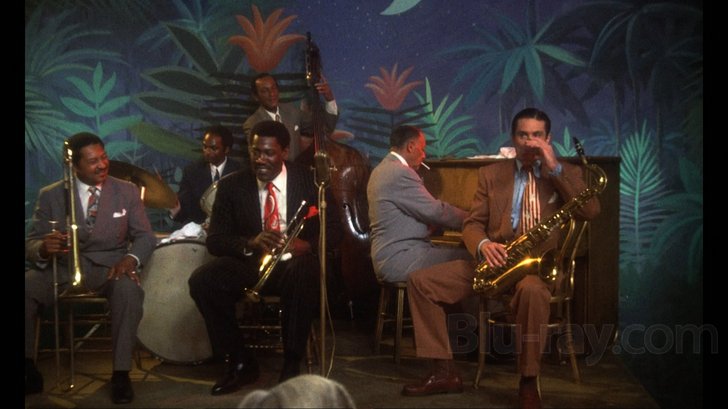
Of one thing I'm certain: The Blu-ray of New York, New York is the first home video version that
provides a fair opportunity to experience the full extent of what Scorsese was attempting to
accomplish. Prior versions allowed you to experience the characters and the performances well
enough, but not the ornately artificial surroundings in which they played out their ill-fated
romance. But since the elaborate decor must receive equal emphasis for Scorsese's frame to
make sense, all prior versions gave a lopsided presentation. The Blu-ray restores the balance.
That doesn't necessarily mean you'll like the film, but at least you'll be judging it on its own
merits. As an accurate representation, the Blu-ray is recommended. As a film, enter at your own
risk.
Similar titles
Similar titles you might also like

The Red Shoes 4K
1948

Carol
2015

West Side Story
50th Anniversary Edition
1961

Cabaret
Reissue
1972

There's No Business Like Show Business
1954

The Jazz Singer
1927

Saturday Night Fever
Director's Cut
1977

Little Women
2019

The Age of Innocence
1993

Absolute Beginners
1986

The Greatest Showman 4K
2017

The Way We Were 4K
50th Anniversary
1973

Sunday Bloody Sunday
1971

Desert Hearts
1985

Fedora
1978

The Artist
2011

Sweet Charity
1969

Song to Song 4K
2017

One from the Heart 4K
1982

From the Terrace
Limited Edition to 3000
1960